Lighting
MIJODRAG ČITAKOVIĆ, ENGINEER, DIRECTOR OF ”DRINA-LIM HYDRO POWER PLANTS”, EXCLUSIVELY FOR ”NATIONAL REVIEW”
Golden Reserve of Serbian Electric Power Industry
Total power of this group of power plants is 1,280 megawatts, which is about 10 percent of the installed power in Serbia. It is especially important that this is ecologically clean energy, from renewable sources, but also that it is peak energy. Peak energy is used during very high consumption and in the world it is 10 to 20 times more expensive! In the coldest winter periods, when all consumption limits are reached and all red lamps are lit up, these power plants operate with full capacity, ”ironing the peaks” and enabling to avoid the crisis of electric power system. The planned revitalization, which is currently in progress, will extend the useful life of these power plants by additional 30 to 40 years
By: Aleksa Mitić
Photographs: Dragan Bosnić
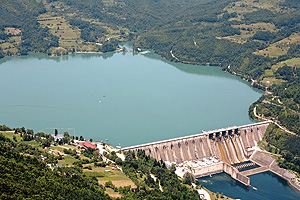 For ”Drina-Lim Hydro Power Plants” it is only fair to say that they are a golden reserve of the electric power system of Serbia. They provide a certain security in power distribution, assist other power plants in times of high consumption, ”iron the peaks”, peak loads, and enable easier planning of certain activities in the future. For ”Drina-Lim Hydro Power Plants” it is only fair to say that they are a golden reserve of the electric power system of Serbia. They provide a certain security in power distribution, assist other power plants in times of high consumption, ”iron the peaks”, peak loads, and enable easier planning of certain activities in the future.
The company ”Drina-Lim Hydro Power Plants”, with the head office in Bajina Bašta, is comprised of four units. The first is the hydro power plant ”Elektromorava” near Čačak (”Ovčar Banja” and ”Međuvršje”), the first one that was renovated in Serbia. The second unit consists of ”Lim Hydro Power Plants” (”Potpeć”, ”Bistrica”, ”Kokin Brod” and ”Uvac”). The third one is hydro power plant ”Zvornik” on the Drina. The fourth unit, sto a hundred kilometers upstream from it: power plants ”Bajina Bašta” (run-of-river and reversible). Except for the reversible power plants ”Bajina Bašta” and ”Uvac”, all of them are more than four decades old.
 – Total power of all our power plants is 1,280 megawatts (about 10 percent of the installed power in Serbia). We produce about 3,280 billion kilowatt hours of electric power, which is 10 to 11 percent of the production of ”Elektroprivreda Srbije” – says for National Review engineer Mijodrag Čitaković, Director of ”Drina-Lim Hydro Power Plants”. – It is also very important for Serbia because we produce, first, ecologically clean energy, second we produce hydro-energy (therefore, from renewable sources) and, the third, peak energy. That peak energy is used in the periods of high consumption and in the world it is 10 to 20 times more expensive than the basic energy, which is produced continuously. For example, thermal power plants and run-of-river hydro power plants continuously produce power and it is much cheaper than t – Total power of all our power plants is 1,280 megawatts (about 10 percent of the installed power in Serbia). We produce about 3,280 billion kilowatt hours of electric power, which is 10 to 11 percent of the production of ”Elektroprivreda Srbije” – says for National Review engineer Mijodrag Čitaković, Director of ”Drina-Lim Hydro Power Plants”. – It is also very important for Serbia because we produce, first, ecologically clean energy, second we produce hydro-energy (therefore, from renewable sources) and, the third, peak energy. That peak energy is used in the periods of high consumption and in the world it is 10 to 20 times more expensive than the basic energy, which is produced continuously. For example, thermal power plants and run-of-river hydro power plants continuously produce power and it is much cheaper than t he power that is produced for peaks. In all this, a special double role is reserved for the reversible hydro power plant. During the night, when thermal power plants work on their technical minimum, only as much so they would not have to turn off the furnaces, and when they have excess power that they cannot introduce into the market, it is used by the reversible power plant. This energy drives electric pumps and water from the lake Perućac is transferred into the lake Zaovine, which is on altitude of 880 meters (the difference between the upper and lower lake is 600 meters). This power that is stocked in the upper lake we introduce into the market in the most critical situations. That is its extremely important role in the electric power industry of Serbia. Capacity of this power plant is 600 MW and practically it can replace one ”Obrenovac” or several power plants within the EPS system that are currently not operational. he power that is produced for peaks. In all this, a special double role is reserved for the reversible hydro power plant. During the night, when thermal power plants work on their technical minimum, only as much so they would not have to turn off the furnaces, and when they have excess power that they cannot introduce into the market, it is used by the reversible power plant. This energy drives electric pumps and water from the lake Perućac is transferred into the lake Zaovine, which is on altitude of 880 meters (the difference between the upper and lower lake is 600 meters). This power that is stocked in the upper lake we introduce into the market in the most critical situations. That is its extremely important role in the electric power industry of Serbia. Capacity of this power plant is 600 MW and practically it can replace one ”Obrenovac” or several power plants within the EPS system that are currently not operational.
ALL ELEMENTS OF REVITALIZATION
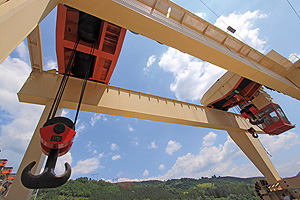 – Coal reserves are provided for thermal power plants, and we have water for the production of power. Some power plants, like ”Uvac”, ”Kokin Brod” and ”Bistrica”, have large accumulations. ”Potpeć” and ”Bajina Bašta” (four aggregates, 100 MW each) must let the Lim, or the Drina, flow through, and these are smaller accumulations. In ”Bajina Bašta” we let the Drina flow through machines, or we use pumps to fill the accumulation ”Zaovine”. Therefore, we must make maximum use of that water, and that is why we bring it back into the lower lake, and not release it directly into the Drina – explains director Čitaković. – Coal reserves are provided for thermal power plants, and we have water for the production of power. Some power plants, like ”Uvac”, ”Kokin Brod” and ”Bistrica”, have large accumulations. ”Potpeć” and ”Bajina Bašta” (four aggregates, 100 MW each) must let the Lim, or the Drina, flow through, and these are smaller accumulations. In ”Bajina Bašta” we let the Drina flow through machines, or we use pumps to fill the accumulation ”Zaovine”. Therefore, we must make maximum use of that water, and that is why we bring it back into the lower lake, and not release it directly into the Drina – explains director Čitaković.
Regarding the capacity renewal, in ”Ovčar banja” and ”Međuvršje” the power was increased by 20 to 25 percent, and the production was increased by almost the same percentage (depending on hydrology), continues Čitaković. The power in ”Bajina Bašta” will be higher b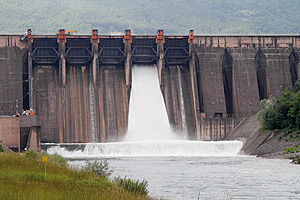 y 13 to 14 percent, which will enable the production of one to two billions of kilowatt hours annually (the average is one billion and 248 millions), i.e. 4.5 percent more than what we have now. However, says Čitaković, in the reconstruction it is not so important to increase the capacity and power production, as the necessity to rejuvenate these power plants, the useful life of which is 30-40 years, and enabling them to operate twice as long. We will achieve capacity increase by mounting more modern machines. Practically, we would get 40 MW more, which is a small power plant that now costs about 80 million euros. And about 72 to 75 million euros will be spent for the revitalization. That is also a significant saving. y 13 to 14 percent, which will enable the production of one to two billions of kilowatt hours annually (the average is one billion and 248 millions), i.e. 4.5 percent more than what we have now. However, says Čitaković, in the reconstruction it is not so important to increase the capacity and power production, as the necessity to rejuvenate these power plants, the useful life of which is 30-40 years, and enabling them to operate twice as long. We will achieve capacity increase by mounting more modern machines. Practically, we would get 40 MW more, which is a small power plant that now costs about 80 million euros. And about 72 to 75 million euros will be spent for the revitalization. That is also a significant saving.
– We have completed the feasibility study for the reconstruction of hydro power plant ”Zvornik” and its revitalization should begin in about one year. It is also more than 40 years old. Then comes ”Potpeć”, and then ”Bistrica”, ”Kokin Brod”, and finally ”Uvac” and the reversible power plant, since they are the youngest – says director Mijodrag Čitaković. – We have managed, with our exp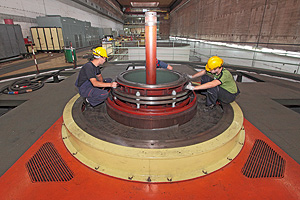 erts, to achieve the most favorable arrangement, less than 200 thousand euros per megawatt. Others would charge five times as much, almost one million euros. You know, today it is difficult to find young qualified professionals who want to work in power plants in small towns. We have managed to retain such young people, to make a good team, and to do everything on our own, from preparation of the project until the contractor. In all four branches we have 530 employees, and based on this we are the most efficient and the most productive within ”Elektroprivreda Srbija” (the fewest people per megawatt and per megawatt-hour). We have achieved this thanks to the automated equipment and professional personnel. Our experts are qualified to complete all the work quickly and with good quality, and we always know precisely what can be completed for how long, for example, how long it would take to repair a malfunction. Because, as you already know, time is money. If the aggregate is not operational for only one hour, that is already a big loss. erts, to achieve the most favorable arrangement, less than 200 thousand euros per megawatt. Others would charge five times as much, almost one million euros. You know, today it is difficult to find young qualified professionals who want to work in power plants in small towns. We have managed to retain such young people, to make a good team, and to do everything on our own, from preparation of the project until the contractor. In all four branches we have 530 employees, and based on this we are the most efficient and the most productive within ”Elektroprivreda Srbija” (the fewest people per megawatt and per megawatt-hour). We have achieved this thanks to the automated equipment and professional personnel. Our experts are qualified to complete all the work quickly and with good quality, and we always know precisely what can be completed for how long, for example, how long it would take to repair a malfunction. Because, as you already know, time is money. If the aggregate is not operational for only one hour, that is already a big loss.
INTERSTATE PROBLEM OF WASTE
 Revitalization in ”Elektroprivreda Srbije” has started with the oldest power plants, those on the Morava River, and it is now in its final phase. The fourth aggregate will be completed by the winter season. Since last June, work is being conducted on the hydro power plant ”Bajina Bašta” as well. The first aggregate is already completed. Exactly when its testing began, huge quantities of waste that were brought by the river damaged the gate. The level of the lake must now be lowered by 18 meters, in order to repair the gate. Revitalization in ”Elektroprivreda Srbije” has started with the oldest power plants, those on the Morava River, and it is now in its final phase. The fourth aggregate will be completed by the winter season. Since last June, work is being conducted on the hydro power plant ”Bajina Bašta” as well. The first aggregate is already completed. Exactly when its testing began, huge quantities of waste that were brought by the river damaged the gate. The level of the lake must now be lowered by 18 meters, in order to repair the gate.
– Last year we removed about 6.000 cubic meters of such waste from the lake! This year there will be more of it by one third, almost 8.000 cubic meters – says engineer Čitaković. – Although we are constantly cleaning, actually all we do is removing the consequences, bu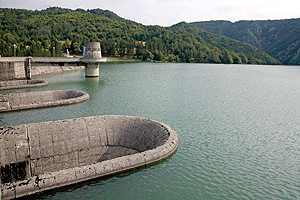 t not removing the cause. The cause includes all the dumps upstream from the Perućac, all the way up to the springs of all rivers that empty into the Drina: the Piva, Tara, Lim, Ćehotina... These dumps are located near waterways and they are the main pollutants. t not removing the cause. The cause includes all the dumps upstream from the Perućac, all the way up to the springs of all rivers that empty into the Drina: the Piva, Tara, Lim, Ćehotina... These dumps are located near waterways and they are the main pollutants.
Solution? Appealing to people’s consciousness, but also a clear penalty policy.
If people from the hydro power plant ”Bajina Bašta” were not cleaning the river in this extent, the waste would also create huge problems in Zvornik, Obrenovac, on Đerdap, and would even reach the Black Sea.
– If we could get rid of the dumps in Priboj, Prijepolje, Bijelo Polje, Brodarevo, it would be a completely different story. The Drina water used to be so clean that you could drink it. Now ligh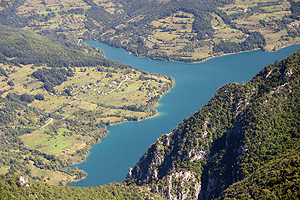 t materials are floating on the surface, and the heavier ones are moved by the water. We used to find old freezers, stoves, wooden logs... Someone was cutting wood, the flood came and washed it into our turbine. t materials are floating on the surface, and the heavier ones are moved by the water. We used to find old freezers, stoves, wooden logs... Someone was cutting wood, the flood came and washed it into our turbine.
This is now an interstate problem, says the first expert of the ”Drina-Lim Hydro Power Plants”. It’s a pity when they have to stop the production to lower the water level in order to repair a malfunction, therefore to work at lowered capacity. That is why they are now postponing the overhaul of the next machine.
– If we put all this on paper, losses would amount to several hundred thousand euros. And if we would add to this the damages because of the interrupted production, we would be afraid to add it up. It would certainly amount to millions of euros. It is necessary to prepare a study on the amount of such unplanned costs caused by people without conscience – says Čitaković.
 
***
Ironing the peaks
It used to happen quite often, as we remember, but for years already, despite the increasing consumption of electrical power, there are no power outages in Serbia. Consumption records are lowered each year. However, even during the coldest winter period, or during these hot summer days, when air-conditioning devices are constantly turned on, there is no power outage.
And exactly then, when all the red lamps lit up, the ”Drina-Lim Hydro Power Plants” begin to work with their full capacity. They ”iron the peaks” of consumption and enable to avoid the crisis of electrical power system.
***
Regattas
The town of Bajina Bašta has matured and become stronger together with the hydro power plant that carries its name. Today, there are no other big companies there. And before the construction of the dam on t he river and creation of the lake, this powerful and moody river was reigned by skillful rafters. They knew each other’s souls, they and the river. And they protected each other. To the memory of the rafters from the Drina, every July the ”Drina Regatta” takes place. As many as twenty thousand people gather. They go down the river from Perućac to Rogačica, on most diverse vessels, in excellent atmosphere, with orchestras, cooking of various gastronomic dishes, and everything that goes with it. The regatta lasts four to five hours, and is remembered forever. That is proven. Guests come from all parts of Serbia, from countries in the region, but also from Canada, Germany, Slovenia, Austria, Norway, England... In a short time, the ”Drina Regatta” has become one of the biggest river regattas in Europe.
***
Tourism
Where there are hydro power plants, there are also lakes, and on the, of course, beaches. On the developed beach in Perućac, during the summer, five to six thousand people come every day to cool down. Next to the lake there is a hotel with bungalows, open plane, and a restaurant. From there you have a beautiful view over the lake and the 90 meter high and 461 meter long dam. Reservations for the hotel in Perućac can be made through the agency ”EPS turs”.
|
